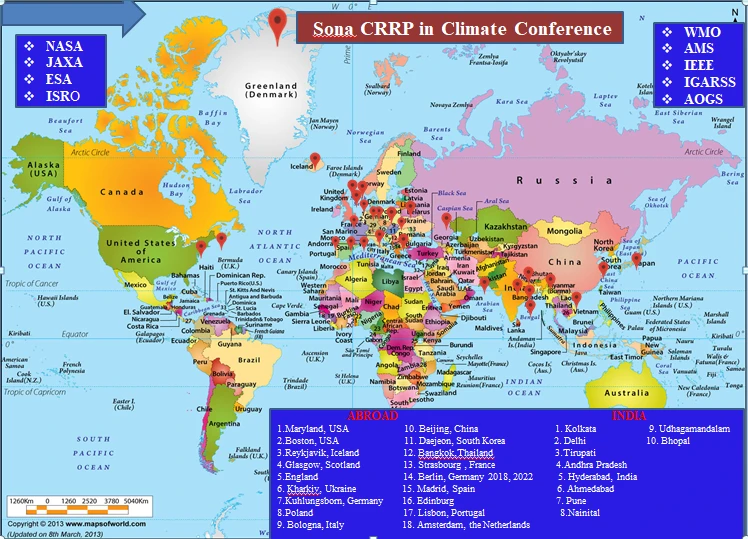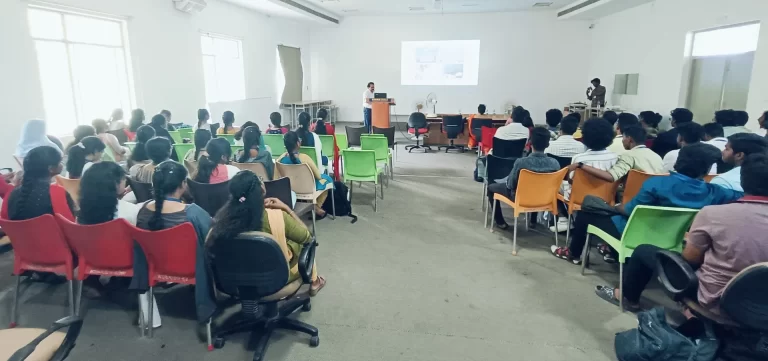

NAAC-Accredited 'A' - Grade 2(f) & 12(B) status (UGC) |ISO
9001:2015 Certified | FIST Funded (DST) SIRO(DSIR)

SONA Centre for study on Rainfall and Radio wave Propagation (SonaCRRP)
The seed of the present Centre for Excellence for the Study on Rainfall and Radio Wave Propagation (CRRP) was sown in February 2003 under the Department of Physics, by Dr. Rajasri Sen Jaiswal. Sona College of Technology stepped into the International arena when Dr. Sen Jaiswal presented her research findings at the 6th International Symposium on Antennas, Propagation, and EM Theory in Beijing, China, in October 2003. She received an International Travel Grant from the CCSTDS (Centre for Co-operation in Science & Technology among Developing Societies) to attend the Conference. Her presentation was published in the Conference Proceeding published by the Institute of Electrical and Electronics Engineers (IEEE).
Dr. Sen Jaiswal actively involved in research since 2003. Approval for the ADCOS Visiting Fellowship of ISRO to her in 2007, her participation at a number of User-Scientist Workshops at the MST RADAR Facility at the National Atmospheric Research Laboratory, ISRO, 2004 onwards, approval of her research projects by the NARL, ISRO, are testimony to her research activities.
By realizing that research activity in various fields is a necessity for any organization and society, as a stepping stone, she conducted a Faculty Development Program on Material Science in 2005. Anna University sponsored the program.
She conducted a State-level seminar on Aerosol and Environmental Pollution in 2004 in the Sona College premises.
By realizing that Atmospheric and Climate Science requires interdisciplinary research, she conducted an International Conference called International Symposium on Rainfall Rate and Radio Wave Propagation in 2007 at Sona College of Technology. The Indian Space Research Organization, Council for Scientific and Industrial Research (CSIR), Tamil Nadu State Council for Science and Technology (TNSCST), and Sona College of Technology sponsored the program. The American Institute of Physics (AIP) published the Conference Proceedings. Almost all working groups of universities and research organizations across India and some other pioneering research organizations, like NASA, NOAA, ISRO, George Mason University, US, Usikov Institute of Radio Physics, Ukraine, the Nigerian Meteorological Society, etc. participated at the Conference.
The name "CRRP” was coined in 2008. Finally, on 12 August 2009, Dr. Abdul Kalam, then President of India, inaugurated the CRRP.
Major Breakthrough
- Cloud liquid water, precipitation water, and latent heat are the key parameters for predicting Rainfall.
- Quantitative rainfall estimation in any geo-location, especially over the ocean, is now possible anytime.
- Precipitation water at the Peak Cloud Liquid Water Level (HPCL) can explain the peaks and troughs of the time series of Rainfall.
- Latitude is the major controlling factor of Freezing Level Height (HFL).
- The RADAR Bright Band Height (BBH)>HFL is a higher latitudinal phenomenon.
- Established radar reflectivity vs. rainfall rate relationship and proved that these two parameters cannot be assumed to have ad hoc relationships as the entire global scientific community accepts. Such relations depend on geography, season, and rainfall intensity.
- Found that the outbreak of corona in 2019 was due to a magnetically weak Sun. The first entry point of the virus in Wuhan (35.59N, 114.30S) was due to the minimum stratospheric thickness at around 30N and 30S.
- Found that the origin of El Nino/La Nina is embedded in the solar cycle. Predicted a La Nina in 2023-2028.
- Showed that the migration of the radar bright band intensity from the northern to the southern hemispheres is opposite to the solar movement and the Inter-Tropical Convergence Zone (ITCZ).
Interaction at the International Level
- CRRP presented at International Conferences at 20 foreign locations, conducted by NASA, NOAA, ISRO, WMO, ESA, AMS, and space agencies of other countries.
- Serving the Editorial Board of International WoS Journals and Conference Proceedings
- Recipient of several International Travel Grants from the Govt. of India
The CRRP engages in the following activities:
- Research
- Academic and related activities
- Conducting National and International Conferences, Webinars, Faculty Development Programs
- Involving students in research, International Conferences
- Arranging Internships, Workshops, and Training Programs for the students for the students
- Getting Research Grants, Conference Grants, and International Travel Grants
- Serving the International Editorial Boards
Message from the Head’s desk
The purpose of research is to unveil the truth. Hence, a researcher is to be honest to the core.
Vision
- To set up a department in atmospheric science and radio wave Propagation
- To build up a self sufficient R&D centre
To find the root cause of climate change
Quantitative estimation of rainfall
To analyze rainfall dynamics - To make an effort to develop an instrument that will measure rainfall and cloud liquid water (CLW), precipitation water (PW), latent heat (LH) at various levels in the atmosphere starting from the Earth’s surface up to 1 km above. If achieved, later it will be extended up to 7 km height.
Mission
- To include more man power in the centre by obtaining research grant/
students’/ faculty involvement/project guidance at UG & PG level
- To obtain research, conference and travel grant
- To approach the Government and the Management for establishing department
- To have stronger national and international collaboration
- Collaboration with ISRO to develop instrument
- Joining ISRO’s space mission by utilizing the satellite outcomes
Objectives
- To unveil the mysteries of the atmosphere and climate



